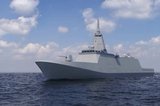Cambridge Pixel supplies radar software to OSI
Cambridge Pixel’s radar simulator software has been supplied to OSI Maritime Systems (OSI) as part of an Integrated Bridge System being delivered to the Royal Malaysian Navy, the company announced on 2 March.
OSI is supplying an Integrated Bridge System to Malaysia for its new Littoral Combat Ships (LCS).
The fully-functioning radar simulator being supplied by Cambridge Pixel includes comprehensive software emulation of the radar control interface based on its SPx radar simulator product.
The simulator includes powerful multi-channel radar video generation with full modelling for realistic terrain and clutter returns. Multiple targets may be defined, each either located in a fixed position - such as a buoy or lighthouse - or moving along motion profiles defined as part of the simulator’s scenario or under remote control from an external source.
To provide a full emulation capability for OSI, Cambridge Pixel augmented the existing radar simulator by emulating the control and status interface of the Kelvin Hughes SharpEye radar used on the LCS. The resulting emulator can be used to fully exercise the radar control, tracking and display functions of OSI’s application software.
David Johnson, CEO, Cambridge Pixel, said: ‘We were delighted to work alongside OSI to support their activities on this significant programme. The modular approach which we bring to all our software products meant that enhancing our existing simulation capability to meet the customer’s detailed requirements was a low-risk development and could be delivered on time and fully compliant.
‘Our radar simulation software and hardware products have supported many customers needing a realistic radar source that can be used to fully exercise tracking and display functionality. We have been able to build on this capability to meet OSI’s needs.’
More from Naval Warfare
-
![US Navy advances with the Harpoon Service Life Extension Programme]()
US Navy advances with the Harpoon Service Life Extension Programme
The US Navy plans to improve Harpoon’s anti-ship and land attack capabilities by equipping the missiles with sensors and technologies required for succeeding in future battlespace.
-
![Future of the Canadian Patrol Submarine Project is still unclear]()
Future of the Canadian Patrol Submarine Project is still unclear
The Canadian government remains tight-lipped on the timeline and funding required for the next steps of its Canadian Submarine Patrol Project, which should offer improved capabilities for the country’s navy.
-
![Mitsubishi eyes future with Australia’s Mogami selection]()
Mitsubishi eyes future with Australia’s Mogami selection
With Australia’s selection of the Mogami-class for Project Sea 3000, Mitsubishi is investigating local production in the next decade as potential export opportunities emerge.
-
![Hanwha wins Australian government approval to increase its stake in Austal]()
Hanwha wins Australian government approval to increase its stake in Austal
The contract would mean the two shipbuilders can collaborate strategically and enhance shipbuilding capabilities in Western Australia.






















